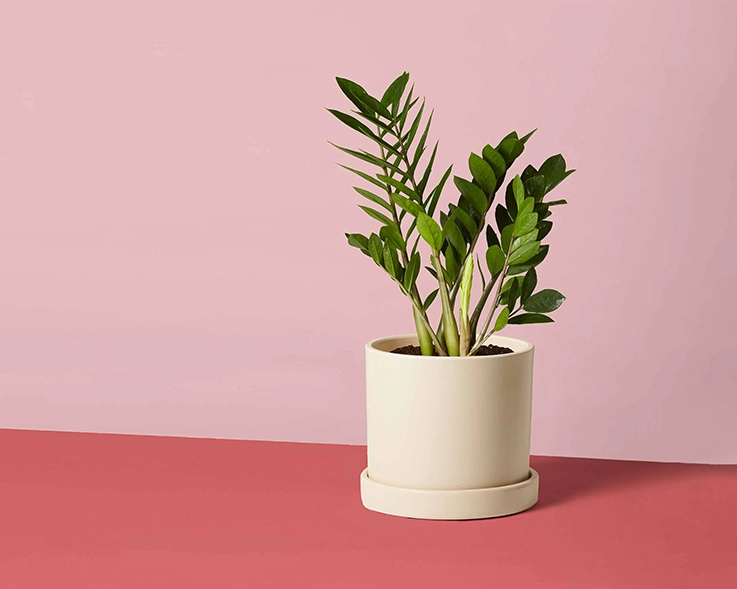Many of us may no longer be in the office five full days a week, “but that doesn't mean your office space has to be a dreary, lifeless place to work,” says Gary Altman, director of the Horticultural Therapy Program at Rutgers University, “especially if you have lots of plants that can survive for long periods of time with little water or care.”
Plus, adding some greenery isn't just aesthetically pleasing: it also has mental benefits: “Studies have shown that having plants in the office can reduce stress and improve productivity and the overall mental health of employees,” says Mark Ashadourian, director of conservatory horticulture and senior curator of orchids at the New York Botanical Garden.
Experts say people tend to choose plants based on their appearance, rather than their need, but for plants to thrive in an office environment, they must be able to tolerate low or indirect light and less watering. Office-friendly plants also need to be suited to the changing temperature and humidity conditions indoors. Ceramic or plastic pots that help retain moisture are likely to be most successful, says Daryl Chen, founder of Houseplant Journal and author of The New Plant Parent, while porous pots like terra cotta tend to allow the soil to dry out faster.
What to watch: Some plant vendors may claim that certain varieties can remove potentially harmful gases called volatile organic compounds from the air. According to the Environmental Protection Agency, VOCs can come from office equipment like printers. But if air-purifying plants sound like a stretch, recent reports suggest that only a very large number of plants in a small office would produce the desired results.
To help you make smart plant choices for your office situation, we asked the experts to share their favorite low-effort plants.
Peace Lily (Spathiphyllum)
For beginners, Altman and Khachadourian recommend peace lilies because you can tell them exactly when to water them. “They get horribly wilted and unsightly,” Altman says. But with a little watering, “they bounce right back, like nothing happened.” But peace lilies aren't a good choice for pet-friendly offices. The ASPCA says the plant is toxic to dogs and cats, and other sources suggest it's at least as harmful.
Bamboo (Bambusaceae)
Bamboo is particularly well-suited for desktops, as it stays green in even low artificial light and won't take up too much space in your office. “Bamboo only needs to be watered every seven to 10 days and will thrive,” says Altman. The standard bamboo houseplant comes in a spiral shape, but you can also opt for a more high-maintenance bundled circular design ($50) or woven trellis style ($60).
Cast Iron Plant (Aspidistra elatior)
If you're likely to be away from the office for long periods of time, the cast iron plant is a hardy choice, true to its name. With glossy, dark green, oval leaves, this plant can grow up to 2 feet long and 4 inches wide with only occasional watering. “The trick to growing a cast iron plant is to not mess with it,” Altman says. “It can survive in many growing conditions where other plants can't.”
ZZ Plant (Zamioculcas zamiifolia)
According to Chen, all our experts consider this pollutant-absorbing plant to be one of the “lowest-maintenance indoor plants.” This is mainly because this variety only needs to be watered when the soil is completely dry, which is about once every two to three weeks. “That's enough that I don't have to worry if I'm away for a few weeks.” Chen likens ZZ's “beautiful upright structure with dense leaves” to a “green statue” because it grows so slowly. Chen keeps a few ZZs by his windowsill, but if your office allows pets, make sure you grow them on a stand or keep them out of reach as they can be toxic to cats and dogs.
Pothos (Epipremnum aureum)
Another nearly self-sufficient option is the pothos, which Chen praises for its “jungle feel.” With long, drooping vines and heart-shaped leaves, the plant (also known as devil's ivy) isn't pet-safe and doesn't do well in bright locations (it will develop yellow spots in direct sunlight, Khachadourian points out), but it thrives in the low-light conditions common in corporate offices, making it “one of the most versatile and adaptable houseplants,” Khachadourian says.
Sansevieria (Dracaena trifasciata, formerly known as Sansevieria)
Also known as “mother-in-law's tongue,” the slender-leafed sansevieria is technically a succulent, but it's hardy enough to survive virtually any condition. “Sansevieria can tolerate pretty much anything except low light, dryness, and extreme overwatering,” says Khachadourian. Though they can be dangerous if ingested by dogs, according to the ASPCA, they're “architecturally great plants” for pet-free offices, Chen notes, and their slow growth means they require little maintenance like pruning or clearing away dead leaves.
Chinese evergreen (Aglaonema)
Despite its leafy name, this plant with patterned leaves comes in a variety of shades, including pink, white, silver and red. Unlike many houseplants, Chinese evergreen thrives in dry, shady conditions and low humidity, says Khachadourian. It's toxic to pets, but its slow growth means you can keep it quietly out of the way on your desk.
Chlorophytum
If you're the type who likes to share with your office mates, the spider web plant is perfect for you. Its long, thin, thread-like leaves grow into a miniature plant that propagates easily. You can gift it potted to a colleague and they'll barely get a hold of it. “From my experience, spider web plants seem to be virtually indestructible,” says Achadourian. “I've seen them thrive in even the most seemingly inhospitable environments.”
Meet the contributorsRachel Chan
Rachel Chan is a WSJ buy-side contributor.

